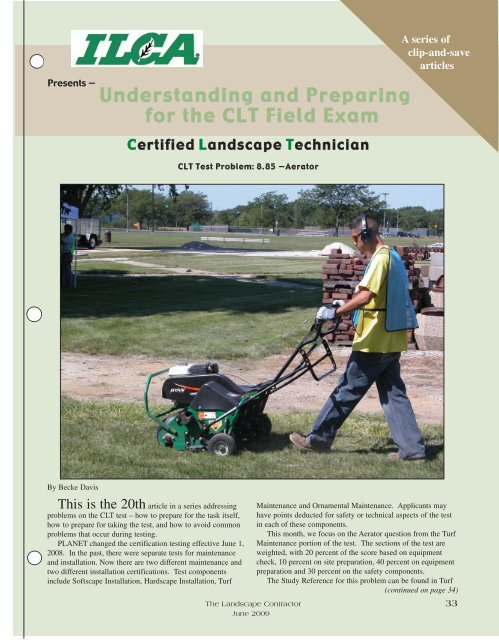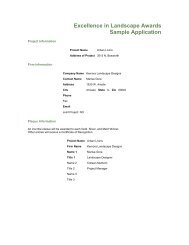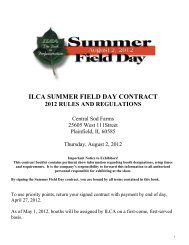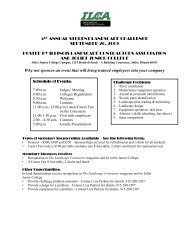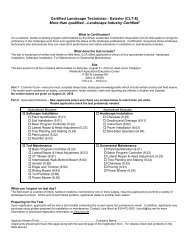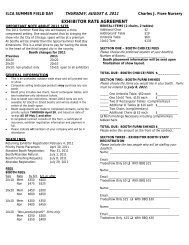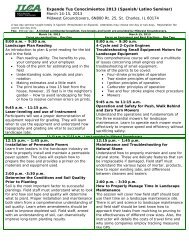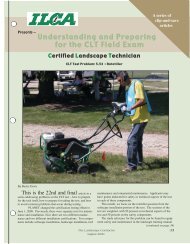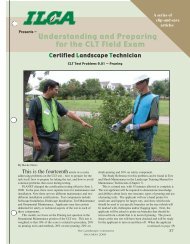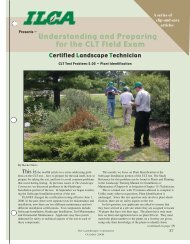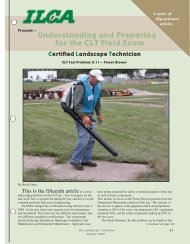8.85 Aerator - Illinois Landscape Contractors Association
8.85 Aerator - Illinois Landscape Contractors Association
8.85 Aerator - Illinois Landscape Contractors Association
- No tags were found...
Create successful ePaper yourself
Turn your PDF publications into a flip-book with our unique Google optimized e-Paper software.
Presents —<br />
U n d e r s t a n d i n g a n d P r e p a r i n g<br />
f o r t h e C L T F i e l d E x a m<br />
Certified <strong>Landscape</strong> Technician<br />
CLT Test Problem: <strong>8.85</strong> —<strong>Aerator</strong><br />
A series of<br />
clip-and-save<br />
articles<br />
By Becke Davis<br />
This is the 20th article in a series addressing<br />
problems on the CLT test – how to prepare for the task itself,<br />
how to prepare for taking the test, and how to avoid common<br />
problems that occur during testing.<br />
PLANET changed the certification testing effective June 1,<br />
2008. In the past, there were separate tests for maintenance<br />
and installation. Now there are two different maintenance and<br />
two different installation certifications. Test components<br />
include Softscape Installation, Hardscape Installation, Turf<br />
Maintenance and Ornamental Maintenance. Applicants may<br />
have points deducted for safety or technical aspects of the test<br />
in each of these components.<br />
This month, we focus on the <strong>Aerator</strong> question from the Turf<br />
Maintenance portion of the test. The sections of the test are<br />
weighted, with 20 percent of the score based on equipment<br />
check, 10 percent on site preparation, 40 percent on equipment<br />
preparation and 30 percent on the safety components.<br />
The Study Reference for this problem can be found in Turf<br />
(continued on page 34)<br />
The <strong>Landscape</strong> Contractor 33<br />
June 2009
C L T F i e l d E x a m P r e p<br />
(continued from page 33)<br />
Equipment Operation and Safety in the<br />
<strong>Landscape</strong> Training Manual for<br />
Maintenance Technicians (Chapter 8).<br />
This is a timed test, with 15 minutes<br />
allowed to complete it.<br />
The test assumes you have been sent<br />
to aerate a lawn. The customer shows<br />
an interest in the<br />
machine, so the test<br />
applicant should take<br />
time to explain how<br />
to check and prepare<br />
the machine for operation.<br />
Prepare the<br />
site, making sure to<br />
remove debris, and<br />
start aerating the<br />
area. Remember to<br />
use caution when<br />
crossing the sidewalk.<br />
Professor<br />
Armando Actis is a<br />
product trainer and<br />
safety instructor. He<br />
has been a CLT judge<br />
since moving to<br />
<strong>Illinois</strong> from New<br />
Jersey in 2002. In<br />
that time, he has<br />
judged a number of<br />
small equipment categories,<br />
including<br />
Power Blower, String<br />
Trimmer, 21-inch<br />
Mower, Edger and<br />
Line Trimmer, Chain<br />
Saw, Tiller, <strong>Aerator</strong><br />
and Concrete Saw in<br />
addition to several mower categories.<br />
As always, safety gear will be on<br />
one of the front tables, in the same area<br />
where applicants read over the test<br />
question. Collecting and actually using<br />
the safety gear should be automatic,<br />
since failure to do so can disqualify<br />
applicants from almost any test. For<br />
this test, ear and eye protection are<br />
required, as are a hat and gloves, long<br />
pants and boots – the usual safety gear<br />
for hand-held power tools. The hat or<br />
cap is not a safety requirement for<br />
using the aerator, but it is necessary to<br />
protect from the sun and heat stroke.<br />
Actis walks us through the test:<br />
“The test applicants should check the<br />
aerator like any internal combustion<br />
equipment, check the oil, and check<br />
the tines. The tines stick out in the<br />
back, and the applicants must check<br />
that they’ve been properly installed,<br />
with nothing loose. The lever on the<br />
machine should be up, in transport<br />
mode – with the tines up. When the<br />
lever is down, the tines should make<br />
contact with the ground, so make sure<br />
that the lever is working.<br />
“Prior to this, the judge (posing as<br />
an interested customer) will ask about a<br />
t-handled tool. The test applicants<br />
should take this tool from the table<br />
when they get their safety equipment.<br />
They should use that to take a soil sample<br />
by pushing it into the earth about<br />
ten inches. Show the judge the soil<br />
sample, and point<br />
out how compacted<br />
it is, how much dirt<br />
is in it and how<br />
much dead grass – a<br />
little or a lot.<br />
Explain why aeration<br />
would work, how the<br />
air would get at the<br />
roots, how the lawn<br />
would benefit from<br />
aeration. They don’t<br />
have to make a scientific<br />
or super-technical<br />
explanation,<br />
just say if the soil<br />
would benefit from it<br />
— and then explain<br />
the benefits of aeration.<br />
“The land where<br />
you will be aerating<br />
will be painted off in<br />
a rectangular U-<br />
shape, where you<br />
take a right-hand<br />
turn and then go<br />
back down. Before<br />
you turn on the<br />
machine, walk the<br />
area and remove any<br />
debris such as pop<br />
cans or branches. The judge may put a<br />
sprinkler head in the test area. It will be<br />
visible, and you if see one, you should<br />
flag it, because where there are sprinkler<br />
heads, there are pipes under the<br />
ground. The tines of an aerator go<br />
down three to four inches, so you<br />
should stay clear of this area.<br />
“Once this is done, turn the machine<br />
on full throttle and put the tines down.<br />
34 The <strong>Landscape</strong> Contractor<br />
June 2009
It’s a heavy machine, and when the test<br />
applicant accelerates, the judge will be<br />
able to see if he’s familiar with the<br />
machine. If you’re not used to it, it’s<br />
like a big St. Bernard pulling you down<br />
the street. Sometimes it’s funny, and<br />
they’ll take off like a cartoon character.<br />
“A judge can tell right away if<br />
you’re using it incorrectly and will stop<br />
you before you can hurt yourself or<br />
somebody else. The judge may give<br />
you one or two chances, but after that,<br />
you fail. (Some may take the test when<br />
they’re normally responsible for planting<br />
trees or flowers. If they pass, fine,<br />
and if not, they can retake that part of<br />
the test in October.)<br />
“To aerate, pull up the lever and aerate<br />
up and down the test area. The<br />
judge will be able to tell quickly if<br />
you’re doing it right. Aerate up and<br />
down. When you get to the turn in the<br />
‘U’, pick up the tines and turn the<br />
machine. One side of the tines will dig<br />
deeper than the other while turning, so<br />
put the tines in transport mode, then<br />
make the turn. Get in position, then put<br />
the tines down and aerate. Do that at<br />
each turn, and pull up the tines at each<br />
turn. The area is about nine feet wide<br />
and the aerator is 18 to 32 inches wide,<br />
so you will have to go up and down two<br />
or three times to get a good coverage<br />
pattern.<br />
“When you’ve finished aerating, pull<br />
up on the tines and transport the<br />
machine back by the table where the<br />
machines are kept. It’s easier if you<br />
transport it while it’s running — just put<br />
it in transport mode.<br />
“As far as safety, the judge can usually<br />
tell in the critical first five minutes<br />
if the applicant has put the safety gear<br />
on and is able to use the machine.”<br />
Actis suggests anyone who plans to<br />
take this test practice before taking it, so<br />
they are familiar with the machine.<br />
The <strong>Landscape</strong> Contractor 35<br />
June 2009


